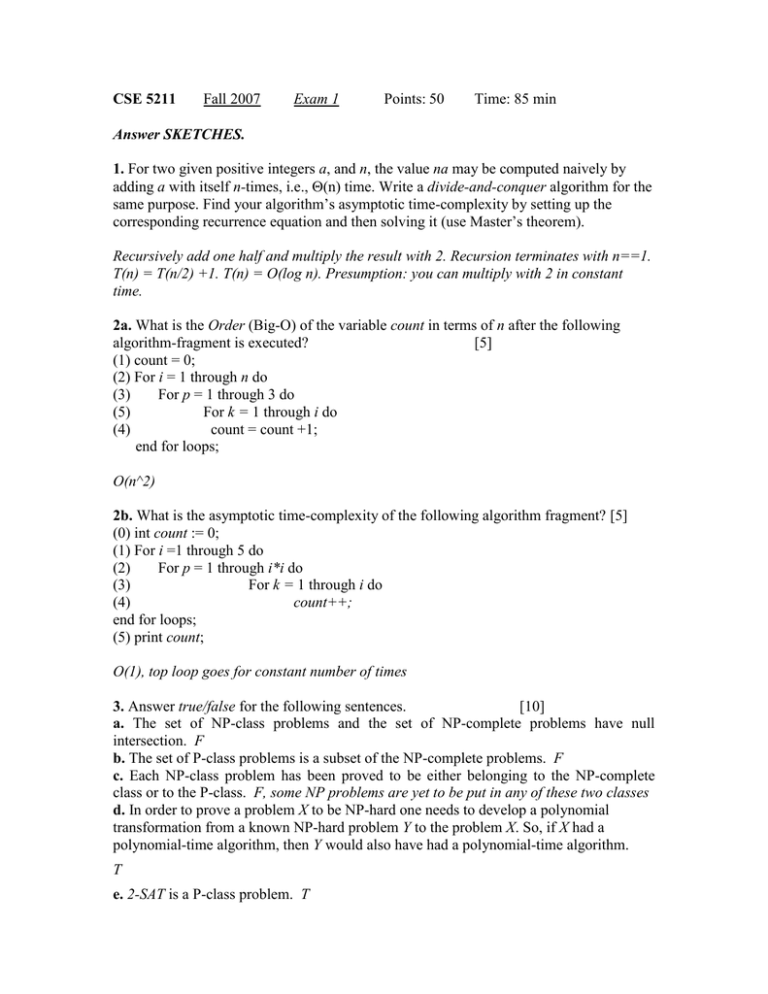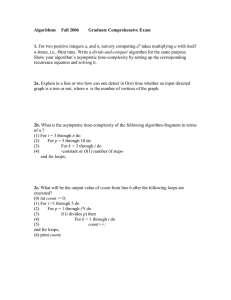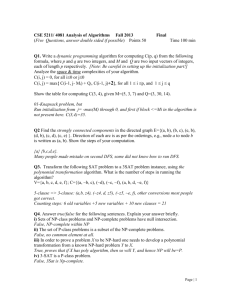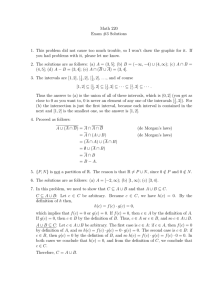CSE 5211 1. Fall 2007
advertisement

CSE 5211
Fall 2007
Exam 1
Points: 50
Time: 85 min
Answer SKETCHES.
1. For two given positive integers a, and n, the value na may be computed naively by
adding a with itself n-times, i.e., (n) time. Write a divide-and-conquer algorithm for the
same purpose. Find your algorithm’s asymptotic time-complexity by setting up the
corresponding recurrence equation and then solving it (use Master’s theorem).
Recursively add one half and multiply the result with 2. Recursion terminates with n==1.
T(n) = T(n/2) +1. T(n) = O(log n). Presumption: you can multiply with 2 in constant
time.
2a. What is the Order (Big-O) of the variable count in terms of n after the following
algorithm-fragment is executed?
[5]
(1) count = 0;
(2) For i = 1 through n do
(3)
For p = 1 through 3 do
(5)
For k = 1 through i do
(4)
count = count +1;
end for loops;
O(n^2)
2b. What is the asymptotic time-complexity of the following algorithm fragment? [5]
(0) int count := 0;
(1) For i =1 through 5 do
(2)
For p = 1 through i*i do
(3)
For k = 1 through i do
(4)
count++;
end for loops;
(5) print count;
O(1), top loop goes for constant number of times
3. Answer true/false for the following sentences.
[10]
a. The set of NP-class problems and the set of NP-complete problems have null
intersection. F
b. The set of P-class problems is a subset of the NP-complete problems. F
c. Each NP-class problem has been proved to be either belonging to the NP-complete
class or to the P-class. F, some NP problems are yet to be put in any of these two classes
d. In order to prove a problem X to be NP-hard one needs to develop a polynomial
transformation from a known NP-hard problem Y to the problem X. So, if X had a
polynomial-time algorithm, then Y would also have had a polynomial-time algorithm.
T
e. 2-SAT is a P-class problem. T
4. The following is a recurrence formula (for aligning sequences with gaps, you need not
be concerned about the problem that the formula models). Develop the output table a[i,j]
of the Dynamic Programming algorithm over two sequences s =AAAC and t =AGC,
where i and j are integers between 0 and 4, and between 0 and 3 respectively.
a[i, 0]= -2i, a[0, j]= -2j,
a[i, j] = max{a[i-1,j]-2, a[i, j-1]-2, a[i-1, j-1] + p(i,j)} for both i and j >0, p(i,j) is 1
when s[i]==t[j], and p(i,j)= -1 when s[i] t[j].
[Hint: You need not write the algorithm. The table will be of 5 x 4 dimension, with rows
corresponding to {0, s[1] through s[4], i.e., A, A, A, C} and columns corresponding to
{0, t[1] through t[3]}. Final score in a[4, 3] will be -1. Show a few sample calculations
for some entries of the table, besides the whole table itself.]
[10]
After initializing the 0-th row and the 0-th column, look for West, Northwest and North
entries of each entry for calculating that entry.
5. The Exon chaining problem is the following:
Input: A set of weighted intervals over the positive integers.
Output: A chain of intervals from this set (no intervals within a chain overlap) such that
the total weight is maximum for all such feasible chains.
Example (draw it): {I1(1, 5, 5), I2(2, 3, 3), I3(4, 8, 6), I4(6, 12, 10), I5(7, 17, 12), I6(9,
10, 1), I7(11, 15, 7), I8(16, 18, 4)}, where the first two numbers indicate the interval and
the third number is the corresponding weight of the interval. Resulting maximum chain:
I2-I3-I6-I7-I8 weighing 21.
Develop a Dynamic Programming algorithm to solve the Exon Chaining problem.
Hint: For the integer i from 1 through max-end-point over all the intervals develop a
scoring array a[i] that stores the maximum weight up to that integer i. For the above
example, the array (from i = 1 through 18) is: 0, 0, 3, 3, 5, 5, 5, 9, 9, 10, 10, 15, 15, 15,
17, 17, 17, 21.
[10]
Recurrence:
s(i) = max { s(i-1), s(i-dk) + wk} if there exists an interval (xk, xk+dk, wk) finishes at i, or
xk+dk=i, if there is no such interval then s(i) = s(i-1).
s(0) = 0.


